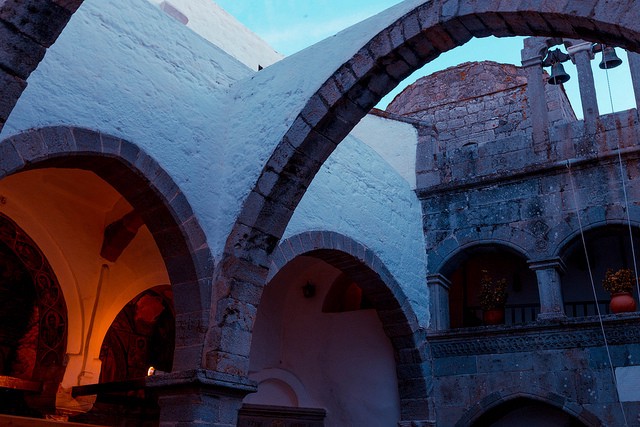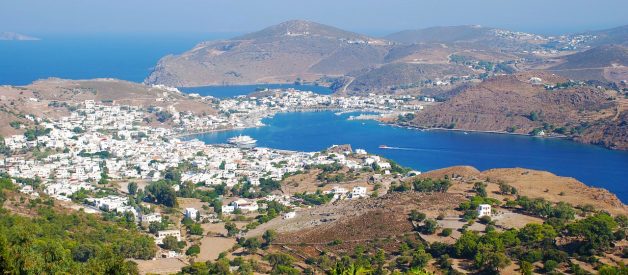The island of Patmos, where John wrote the biblical book of Revelation, has become a versatile vacation destination. It attracts everyone from wealthy socialites to artistic recluses.
The island?s mystical draw (some say it ?vibrates?) along with its natural beauty and history, make it one of the fascinating places to visit in Greece. Visitors interested in Christian history will find some of the most significant sites in the world on Patmos.

History
Patmos?s history precedes the penning of the Bible?s apocalyptic narrative, as it has been inhabited since about 3000 B.C. Its original name, Litois, is drawn from Greek mythology. Legend has it the goddess Artemis persuaded her father Zeus to raise the island from the sea after it had sunk underwater.
The island?s residents, in their devotion to Artemis ? who was also called Litoida ? named it after her. Another Greek myth links the island to Orestes, who supposedly murdered his mother Clytemnestra before escaping to Patmos.
Archaeological finds show that the island?s population boomed during the Peloponnesian Wars. However, after the Romans conquered Patmos, its population began to decline and the island became an exile for convicts. In 95 A.D., the Roman emperor Titus Flavius Domitianus exiled the Apostle John there.
On the island, John wrote down his visions of the Apocalypse that became the book of Revelation. In subsequent years, the culture of Patmos was shaped by the Christian pilgrims and worshippers who came there. They built hundreds of churches, monasteries, and other religious shrines in order to honor Saint John.
The island experienced periods of decline and prosperity over the centuries. It was occupied by other empires before gaining independence. In the 12th century, Patmos became a trading center and grew wealthy.
It was fortified with great walls to protect it from pirates, and in the 1600s the islands monks became its rulers. In 1948, Patmos joined the Dodecanese islands in becoming part of Greece. The national government designated it as the ?Holy Island? in 1981.
The Monastery of Saint John
The legacy of Saint John lives on through significant religious sites in Patmos. The monastery of Saint John stands above Skala, the main town on the island. The monastery was originally built both as a religious home and to discourage pirates from targeting the island.
The monastery was constructed in 1088 A.D. and looks like a fortress, as its thick walls are more than 15 meters high. Ossios Christodoulos founded the monastery with a grant from the Byzantine emperor.
 Image by CaptSpaulding | Flickr
Image by CaptSpaulding | Flickr
Its perch above the town makes it the most visible structure on the island. Look closely as you enter and you?ll see an old booby trap. Right above the entrance is a small opening where defenders could pour water, hot oil, or lead on invaders.
Inside the walls, visitors will find a quiet sanctuary that exemplifies monastic life and worship. As you walk toward the main chapel, be sure to notice four arched colonnades with paintings. The upper row depicts miracles of Saint John the Divine and are from the 17th century. Inside the main chapel are pieces of the holy cross and the skull of Saint Thomas.
The refectory is a 50 square-meter room behind the chapel of the Virgin Mary. It houses two long tables where monks ate their meals. A closer look will reveal divots in the table where monks put their personal belongings.
On the walls is artwork dating to 1180 A.D. The kneading troughs and stone oven in the old bakery off the main courtyard were mentioned by Holy Christodoulos in his writings, in which he discussed that a ?cellar man? was chosen to oversee the room.
Visitors will find the most significant of the site?s religious artifacts in the its museum, which is next to the bakery and charges a small entrance fee. It contains many of Christodoulos?s icons along with religious relics, original Bible manuscripts, vestments, and gold and silver objects. The on-site library contains many of the books Christodoulos brought to the island along with 900 manuscripts.
The Cave of the Apocalypse
After Saint John was exiled from Rome, he fled to Patmos for safety. Visitors from all over the world now come to the island to see the cave where Saint John purportedly wrote the book of Revelation. Legend holds that he received visions from God about the end times via a voice that came from a cleft in a rock.
Later, a sanctuary and monastery were built around the cave, which remains open to visitors. A mosaic of John?s visions has been installed at the front of the cave. Inside, visitors will see the niche where John rested his head every night.
A large silver lamp marks where the saint slept, and his rock pillow is still on display. If you linger, a monk likely will come by to tell the story of John?s revelations. Before leaving, look for a triple fissure (which represents the Holy Trinity) where John heard God?s voice.


